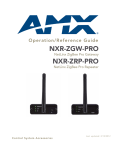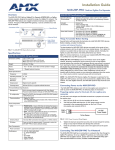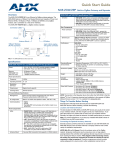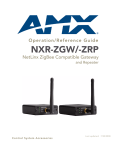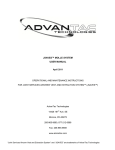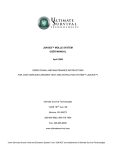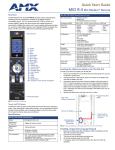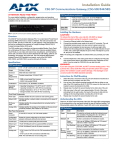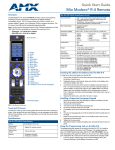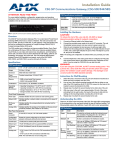Download AMX NXR-ZRP Installation guide
Transcript
Installation Guide NXR-ZGW-PRO NetLinx ZigBee Pro Gateway Overview NXR-ZGW-PRO Specifications (Cont.) The NXR-ZGW-PRO (FG5791-11) is an Ethernet to ZigBee wireless gateway, designed as the center of a ZigBee® Pro network. The NXR-ZGW-PRO features a 10/100BaseT, auto-negotiating Ethernet port capable of Power over Ethernet (PoE), 16 Mbytes of Flash, 16 Mbytes of SDRAM, and a ZigBee Pro transceiver, and is controlled via a web server interface. Rear Components: Connection LEDs PWR/STATUS LAN Power connector • 2-pin 3.5mm captive-wire connector • Power Over Ethernet (PoE) - powers the device through the CAT5 cable. Both Power and Data can be transmitted simultaneous through the CAT5 cable when using the appropriate equipment. Ethernet port 10/100BaseT Modular (RJ-45) connector - connects the NXR-ZGW-PRO to your LAN. Certifications: • • • • • • Operating/Storage Environments: • Operating Temperature: -30°C (-22°F) to 70°C (158°F) • Relative Humidity: 5% to 85% non-condensing; intended for indoor use only Included Accessories: • Rubber feet • Velcro mounting strip • 2.4GHZ, MONO, RSMA, 3.5IN, 2.0DBI Antenna (70-0012-SA) • Power Supply (24-5791-SA) Other AMX Products: • • • • RF ANT (Front) ID Antenna Mount ID Button 10/100BaseT Modular (RJ-45) connector 2-pin 3.5mm captive wire power connector ETHERNET PoE (Rear) 12VDC PWR FIG. 1 NXR-ZGW-PRO (front and rear) Specifications NXR-ZGW-PRO (FG5791-11) Specifications FCC ID: CWU-NXRZGWPRO IC: 5078B-ZGWPRO CE IEC-60950-1 Japan Approval ZigBee Certified Mio Modero R-3 Remote (FG148-03) Mio Modero R-4 Remote (FG148-04) NXR-ZRP-PRO ZigBee Pro Repeater (FG5791-03) AC-DIN-ZIGBEE DIN Rail Mounting Bracket (FG532-06) Things To Consider Before Starting Dimensions (HWD): 4.50" x 2.50" x 0.94" (114.30 mm x 63.50 mm x 23.81 mm) Note: length does not include antenna Several factors will help decide the best place to install NXR-ZGW-PRO gateway devices. Before installing, consider the following: Weight: • Without Antenna: 0.35 lbs (158.75g) • With Antenna: 0.40 lbs (181.44g) Power: • 10.5 - 18 VDC; (13.5 VDC nominal operation voltage) • Power over Ethernet (PoE) Class 2 The best location for NXR-ZGW-PRO devices are usually in the center of your wireless network, with line of sight to all of your mobile devices. Try to place the antenna in a position that can best cover your wireless network. Normally, the higher you place the antenna, the better performance you receive. Memory: • 16 Mbytes of Flash • 16 Mbytes of SDRAM Note: For minimal interference, try to keep any installed NXR-ZGW-PRO at least 10’ (3.048m) from any WiFi access points. Radio Specifications: Frequency 2.4GHz Operating channels 11 - 26 Modulation technique DSS Output power Region/country specific Coverage area 165 feet (50.2m) Firmware/Software Specifications: Management Built-in browser-based management with User Name/ Password authentication IP configuration Static IP or DHCP client (default is DHCP/Zeroconf) Communications • ZigBee • TCP/IP Front Components: LEDs • PWR/STATUS - Blinking green LED: the device is installed and communicating properly. Power ON, but no master connection, is indicated with a solid light, Power OFF is indicated with no light. • LAN - Green LED: Ethernet connection is established. Blinking: indicates both sending and receiving information via Ethernet. • RF - Solid LED: end devices are connected; no LED: end devices not connected; LED blinks to indicate activity. Antenna Mount A reverse SMA connection that supports a 2.4GHz antenna. ID Button • When used in conjunction with NetLinx Studio, sets the device and system numbers for the NXR-ZGW-PRO. Press and hold for approximately 30 seconds to return the NXR-ZGW-PRO to factory default settings. Location and Antenna Direction NOTE (Mio R-3 or R-4 Users): Due to the wireless nature of the ZigBee network, temporary interference (such as leaving a room or large objects passing between the controller and its gateway device) may prevent a command from reaching the NetLinx master. If this happens while increasing volume, the master may receive the command to increase the volume but not the command to stop increasing it. Therefore, programmers should consider setting safeguards for volume control, either established volume limits or timeouts with the NetLinx master or more interactive adjustment from the remote (i.e., direct volume control), to prevent issues with lost commands. For more information on installing a ZigBee network, please refer to the ZigBee Installation Guide, available at www.amx.com. Connecting Power to the NXR-ZGW-PRO The NXR-ZGW-PRO receives power via either PoE or 2-pin 3.5 mm mini-captive wire connection, the NXR-ZRP only utilizes the 2-pin 3.5 mm mini-captive wire connection. If PoE is selected, the NXR-ZGW-PRO will draw power through the CAT5 Ethernet cable at approximately 60mA at 48V. If the 2-pin 3.5 mm mini-captive wire connector is selected, as in cases where the available power through the Ethernet cable is insufficient for operation, the following steps are necessary: Preparing captive wires for the 2-pin 3.5 mm mini-captive wire connector You will need a wire stripper and flat-blade screwdriver to prepare and connect the captive wires. 1. 2. Strip 0.25 inch (6.35 mm) of wire insulation off all wires. The PWR and GND cable from the 12 VDC power supply must be connected to the corresponding location on the 2-pin 3.5 mm mini-captive wire connector (FIG. 2). PWR + GND - 12 VDC Power Supply To the Device FIG. 2 12 VDC Power Connector Wiring Diagram 3. 4. Tighten the clamp to secure the two wires. Do not over-torque the screws. Verify the connection of the 2-pin 3.5mm mini-captive wire to the power supply. Connecting the NXR-ZGW-PRO to a LAN Insert one end of the CAT5 Ethernet cable into the rear RJ-45 jack. Connect the other end of the same cable to a master, or to a switch connected to a master. Setting Up A Network After you have established the location of the gateway, connected it, provided power, and placed the device in either a rack or wall installation, you can then begin configuring the NXR-ZGW-PRO and adding an NXR-ZRP-PRO and other ZigBee-compatible devices to the network. 1. 2. 3. 4. 5. 6. 7. 8. 9. Confirm that the NXR-ZGW-PRO is receiving power by checking the PWR LED (shown in FIG. 1). Using a PC connected to your NetLinx system, open a web browser equipped with Zeroconf or NetLinx Studio 3. The NXR-ZGW-PRO will show up in the Zeroconf list as AMX NXR-ZGW-PRO SN# XXXX (“XXXX” being the 16-digit serial number of the NXR-ZGW-PRO). Double click on the device and the NXR-ZGW Browser-based Configuration Manager will be brought up. If Zeroconf is not available, open a telnet session with the master and use the command "show system" to obtain the IP address of the NXR-ZGW-PRO. If more than one master is on the subnet, the NXRZGW-PRO will connect to the first one it senses, so having only one master is highly recommended. Go to the NetLinx setup page and configure the NXR-ZGW-PRO to communicate with the master. Go to the PAN/Network tab and enable the wireless network. Turn on ZigBee-compatible devices one at a time, e.g., Mio R-3, Mio R-4 or NXR-ZRP-PRO. This ensures that they are fully booted up before attempting to join the network. Go to the Pan/Commissioning tab and allow joining. This enables joining for one minute and may need to be repeated periodically. Start a network survey and select the appropriate extended PAN ID. For devices that do not have displays, such as the NXR-ZRP-PRO, or ones that have an insufficient display to allow selection of the PAN ID to join a network, place each device one at a time near the gateway, turn on one of the devices, and configure it using the gateway web pages before turning on the next one. Once configured, use the PAN pages to change the devices over to a new PAN ID. NOTE: If a repeater has been previously configured to a PAN, it must be reset to factory defaults before it can join a different PAN. This method may also be used if you do not want to go to each ZigBee compatible device to set the PAN ID. However, once each device is set, the change must be made to the gateway itself. It may be necessary to cycle power on each device for them to come online. Due to the wireless nature of the ZigBee network, temporary interference (such as leaving a room or large objects passing between a remote and its gateway device) may prevent a command from reaching the NetLinx master. If this happens while increasing volume, the master may receive the command to increase the volume but not the command to stop increasing it. For more information, please refer to the ZigBee Tips Installation Guide, available at www.amx.com. NXR-ZGW Configuration Manager Pages To access the NXR-ZGW Browser-based Configuration Manager pages, enter the IP address of the NXR-ZGW-PRO into your web browser. NOTE: The default IP configuration for the NXR-ZGW-PRO is DHCP/Zeroconf. A random link-local address is selected automatically if DHCP fails. Zeroconf will advertise this and allow connection. Setting the IP Address 1. 2. 3. Upon accessing the NXR-ZGW Browser-based Configuration Manager, the user must enter a username and password. The default username and password entries are “Admin” and “1988”; changing the password as soon as possible is highly recommended. In the menu at the top of the Configuration Manager, select IP Settings under the section Configuration. Click the radio button for either Dynamic or Static. If your network has a DHCP server, you may select 'Dynamic', and the gateway will request IP 4. 5. information from the server. If configured for “Static,” type the IP address in the field provided. If necessary, type the subnet mask and gateway in the fields provided. Click Accept. Setting the ICSP connection to the Netlinx master 1. 2. 3. 4. 5. 6. In the menu at the top of the NXR-ZGW Browser-based Configuration Manager, select NetLinx Settings under the section Configuration. Select the connection mode: TCP Auto, TCP URL, TCP Listen, or UDP URL. Enter the device number to be assigned to the NXR-ZGW-PRO in the Device Number field. If using TCP URL or UDP URL, enter the IP address of the master that the NXR-ZGW-PRO is to connect with in the Master IP/URL field. If using TCP Auto mode, enter the system number of the master that NXR-ZGWPRO is to connect with in the System Number field. If the connecting master has ICSP Security enabled, enter the Username and Password in the appropriate fields. Click Accept. Setting a new username and password 1. 2. 3. 4. 5. Select User Settings under the section Configuration. In the text field next to New Username, type the new name. In the text field next to New Password, type the new password. Confirm the password in the field Re-type Password. Click Accept. Personal Area Network Enabling and disabling the wireless network 1. 2. 3. 4. In the menu on the top of the NXR-ZGW Browser-based Configuration Manager, select Pan/Network. Click the Enabled radio button in the Network section to enable the wireless network or select Disabled to disable the network. Select a channel, or leave set to Any and the device will automatically select the best channel. Click Accept. Connecting devices to a PAN 1. 2. 3. 4. 5. 6. 7. In the menu on the top of the NXR-ZGW Browser-based Configuration Manager, select Pan/Commissioning If the device is not on the network and is set to factory defaults, make sure the device is powered and click the Allow Joining button. Wait for the device to show up in the Commissioning tab. Click on the EUI-64 link to open the Device Details page. In the Extended PAN ID field, enter the desired Extended PAN ID for the repeater within the network. This field will default to the current network. Click Update Settings. Repeat steps 1-6 for each repeater to be added to the network. Utilities Allowing firmware updates to devices 1. 2. 3. 4. 5. In the menu on the top of the NXR-ZGW Browser-based Configuration Manager, select Utilities/Device Firmware. Choose the device to be updated by its EUI-64 number. To allow updates to individual devices, click the button next to the device’s EUI-64 number in the Allow Updates column. The page will automatically refresh, displaying the device’s new status. To update all of the devices on a network, click All On or All Off in the Allow Updates column to allow or block upgrades to all devices on the network. The page will automatically refresh, displaying the new status of all network devices. The NXR-ZGW-PRO may not update all devices at once to limit network traffic. Devices that operate on battery power will need to be placed in a charger before the update can take place. Patents This product employs or practices certain features and/or methods of one or more of the following patents: SIPCO, LLC U.S. Patent No. 7,103,511 U.S. Patent No. 6,914,893 U.S. Patent No. 7,697,492 For full warranty information, refer to the AMX Instruction Manual(s) associated with your Product(s). 5/11 ©2011 AMX. All rights reserved. AMX and the AMX logo are registered trademarks of AMX. AMX reserves the right to alter specifications without notice at any time. 3000 RESEARCH DRIVE, RICHARDSON, TX 75082 • 800.222.0193 • fax 469.624.7153 • technical support 800.932.6993 • www.amx.com 93-5791-11 REV: C


